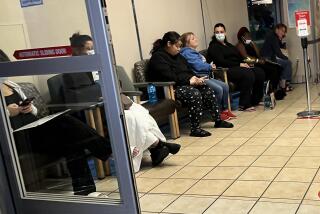Study Lends Support for Nurse-to-Patient Ratio Laws
- Share via
A patient’s risk of dying from routine surgery is higher at hospitals with fewer nurses at the bedside, according to research published in today’s Journal of the American Medical Assn.
The study, conducted by University of Pennsylvania researchers, appears to validate California’s legislative efforts to limit the number of patients assigned to each hospital nurse. California is the first and only state to approve nurse-to-patient ratios, which take effect in January 2004.
The researchers concluded that inadequate nursing levels lead to thousands of avoidable deaths each year. They also found that a patient’s risk of death within 30 days of admission increased by about 7% for every additional patient in a nurse’s workload.
If a typical nurse is responsible for six patients, rather than four, patients had a 14% greater chance of dying after surgery. The mortality rate increases by 31% if a nurse’s patient load increases to eight from four.
“We find a really strong and unequivocal relationship between nurse staffing and mortality,” said Linda Aiken, director of the Center for Health Outcomes and Policy Research at Penn’s nursing school. “We hope that this will help resolve the issue of whether this is a big problem or a small problem.”
Researchers examined data from 168 hospitals, 232,342 surgical patients and 10,184 nurses in Pennsylvania. The patients underwent general, orthopedic or vascular procedures in 1998 and 1999. Such surgeries include gallbladder removals and knee and hip replacements.
The study found that burnout and job dissatisfaction are higher among nurses with more patients under their care. Those nurses said they were far more likely to leave the profession than their peers.
Aiken suggested that hospitals could counteract the nurse shortage if they were able to retain stressed nurses who now are likely to quit because of poor working conditions.
In California, supporters of the nurse-to-patient ratios hailed the study. Rose Ann DeMoro, executive director of the California Nurses Assn., said nurses would return to work in hospitals if the conditions were more reasonable.
“A lot of what drives nurses out of nursing is a crisis in conscience,” DeMoro said. “They feel that they go home at night, and they’re extremely concerned and depressed about what’s happening with their patients.”
Indeed, Aiken’s article called California’s ratio law “a credible approach to reducing mortality and increasing nurse retention in hospital practice ... “
But critics of the ratios say hospitals cannot recruit enough nurses to fill the slots.
California has the second-lowest number of registered nurses per capita in the country. And the state’s colleges aren’t even graduating enough nurses each year to replace those who retire, said Dorel Harms, vice president of professional services at the California Healthcare Assn., a hospital trade group.
Hospital leaders say they need the flexibility to change the staffing mix based on the severity of patients in the hospital and the time of day. Patients asleep at night, for instance, may require less supervision than those awake during the day.
The ratios in California would vary depending on the hospital unit in which a patient is staying. In trauma units, for instance, the ratio would be as high as one nurse for every patient. In medical-surgical units, it would be one nurse for every six patients in 2004 and then drop to one nurse for every five patients.
Before the regulations take effect, state health officials will hold three hearings around the state to hear public comments. The first will take place at 10 a.m. Nov. 15 at the Ronald Reagan state office building, 300 S. Spring St., in Los Angeles.






